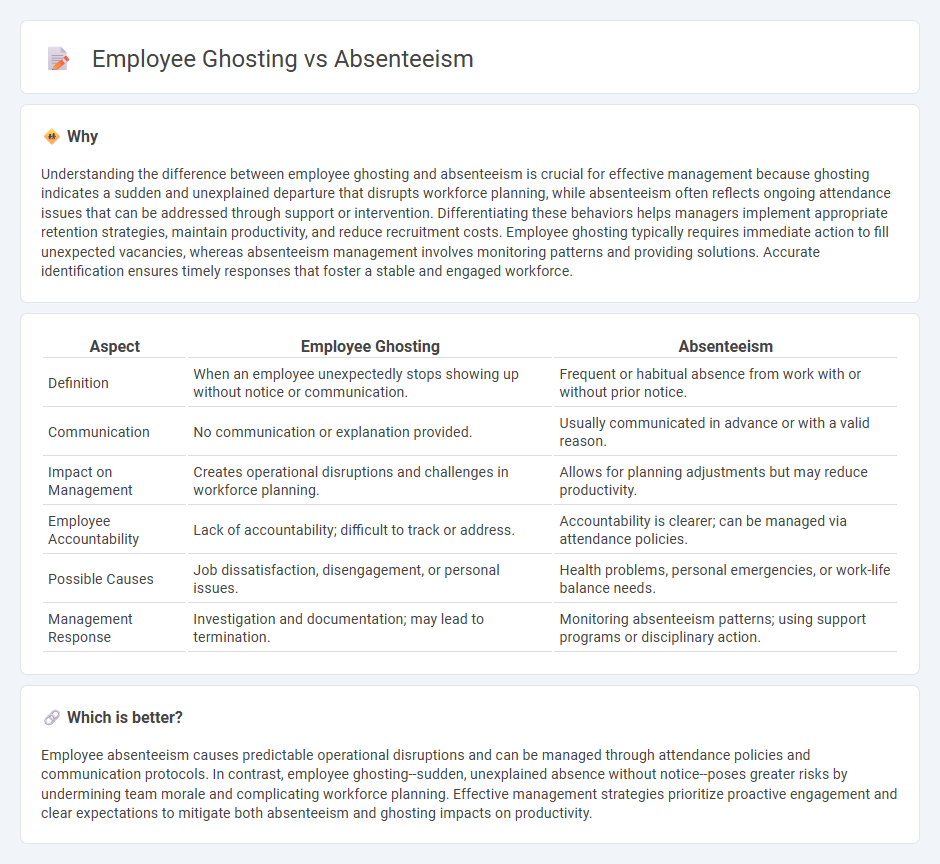
Employee ghosting refers to workers abruptly disappearing from their roles without notice, while absenteeism involves frequent or habitual absence with or without valid reasons. Both behaviors negatively impact productivity, workplace morale, and operational efficiency. Explore strategies to address and prevent ghosting and absenteeism effectively in your organization.
Why it is important
Understanding the difference between employee ghosting and absenteeism is crucial for effective management because ghosting indicates a sudden and unexplained departure that disrupts workforce planning, while absenteeism often reflects ongoing attendance issues that can be addressed through support or intervention. Differentiating these behaviors helps managers implement appropriate retention strategies, maintain productivity, and reduce recruitment costs. Employee ghosting typically requires immediate action to fill unexpected vacancies, whereas absenteeism management involves monitoring patterns and providing solutions. Accurate identification ensures timely responses that foster a stable and engaged workforce.
Comparison Table
| Aspect | Employee Ghosting | Absenteeism |
|---|---|---|
| Definition | When an employee unexpectedly stops showing up without notice or communication. | Frequent or habitual absence from work with or without prior notice. |
| Communication | No communication or explanation provided. | Usually communicated in advance or with a valid reason. |
| Impact on Management | Creates operational disruptions and challenges in workforce planning. | Allows for planning adjustments but may reduce productivity. |
| Employee Accountability | Lack of accountability; difficult to track or address. | Accountability is clearer; can be managed via attendance policies. |
| Possible Causes | Job dissatisfaction, disengagement, or personal issues. | Health problems, personal emergencies, or work-life balance needs. |
| Management Response | Investigation and documentation; may lead to termination. | Monitoring absenteeism patterns; using support programs or disciplinary action. |
Which is better?
Employee absenteeism causes predictable operational disruptions and can be managed through attendance policies and communication protocols. In contrast, employee ghosting--sudden, unexplained absence without notice--poses greater risks by undermining team morale and complicating workforce planning. Effective management strategies prioritize proactive engagement and clear expectations to mitigate both absenteeism and ghosting impacts on productivity.
Connection
Employee ghosting and absenteeism both reflect disengagement and lack of communication within the workplace, leading to reduced productivity and increased operational costs. Ghosting occurs when employees abruptly stop responding or showing up without notice, while absenteeism involves frequent, often unplanned, absences that disrupt workflow and team dynamics. Addressing underlying issues such as job dissatisfaction, poor management, or workplace stress is critical to reduce these behaviors and improve employee retention.
Key Terms
Attendance
Absenteeism refers to habitual or frequent absence from work, often due to illness or personal reasons, while employee ghosting involves an unexpected and unexplained absence without communication. Attendance tracking systems and HR policies help distinguish patterns of absenteeism from sudden ghosting incidents that disrupt workforce planning. Explore detailed strategies and solutions to effectively manage attendance challenges and reduce employee ghosting.
Retention
Absenteeism refers to the habitual nonattendance of employees at work, often leading to decreased productivity and increased operational costs, while employee ghosting involves employees abruptly disengaging and disappearing without notice, causing significant disruption to team dynamics and project continuity. Effective retention strategies target both issues by fostering engagement, improving workplace culture, and implementing clear communication protocols to reduce unexpected departures and absenteeism rates. Explore comprehensive retention approaches to minimize these challenges and secure a stable, committed workforce.
Communication
Absenteeism refers to employees frequently missing work due to various reasons, whereas employee ghosting involves a sudden and uncommunicated disappearance from the workplace, often during onboarding or early employment. Effective communication strategies can reduce absenteeism by addressing underlying issues, while open dialogue and clear expectations can prevent ghosting by fostering trust and engagement. Explore our resources to deepen your understanding of combating absenteeism and ghosting through improved communication.
Source and External Links
Fighting Employee Absenteeism: 5 Expert Tips You Need - This article provides strategies to combat absenteeism, which has increased significantly since pre-pandemic times, driven by stress, mental health concerns, and quiet quitting.
Absenteeism - Absenteeism refers to a habitual pattern of absence from work without good reason, often seen as a management problem reflecting broader issues.
Absenteeism: Definition, Causes, and Remedies - This article discusses absenteeism as frequent absences exceeding reasonable limits, driven by factors such as lack of engagement, poor health, and workplace issues.
 dowidth.com
dowidth.com